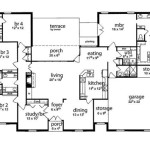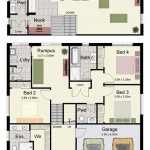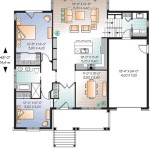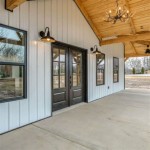Design Your Dream Home With Architect-Crafted House Plans PDF
The process of designing a dream home is a deeply personal and often complex undertaking. It involves a multitude of decisions, encompassing aesthetics, functionality, and budget considerations. While engaging an architect for a fully bespoke design is the ideal scenario for many, accessing architect-crafted house plans in PDF format offers a cost-effective and flexible alternative. These plans provide a solid foundation for realizing a vision while allowing for customization and adaptation to individual needs and site-specific conditions.
Architect-crafted house plans PDF documents represent a significant advancement in accessibility to professional design services. Traditionally, obtaining detailed architectural blueprints required direct engagement with an architect, often incurring substantial fees. The availability of PDF plans allows homeowners to browse through a diverse range of pre-designed layouts, styles, and sizes, selecting a design that closely aligns with their preferences and requirements. These plans typically encompass detailed floor plans, elevations, sections, and in some cases, even 3D renderings, providing a comprehensive visualization of the proposed dwelling.
The ability to review and manipulate these plans digitally offers considerable advantages. Homeowners can easily examine the spatial arrangements, identify potential modifications, and share the plans with contractors and consultants for pricing and feasibility assessments. The PDF format ensures consistent rendering and accurate measurements across different devices, minimizing the risk of misinterpretations during the construction phase.
Key Advantages of Using Architect-Crafted House Plans PDF
Several compelling reasons advocate for the consideration of architect-crafted house plans in a PDF format when embarking on a home building project. These advantages span cost-effectiveness, design quality, and flexibility.
Cost-Effectiveness: One of the primary benefits of purchasing house plans in PDF format is the significant cost savings compared to commissioning a custom design. Engaging an architect for a fully bespoke design involves considerable time and effort, translating into higher fees. Pre-designed plans, on the other hand, represent a fraction of the cost, making professional architectural designs accessible to a wider range of homeowners. This allows individuals to allocate their budget towards higher-quality materials, enhanced finishes, or other value-added features of their home.
Design Quality: Architect-crafted house plans are developed by qualified professionals with extensive training and experience in residential design. This ensures that the plans adhere to building codes, incorporate sound structural principles, and optimize spatial arrangements for functionality and livability. Engaging an architect, even through the purchase of pre-designed plans, provides a level of assurance regarding the quality and integrity of the design that is not always present in other sources of generic building plans.
Flexibility and Customization: While pre-designed, these plans are not necessarily rigid. Architects often design the plans with the intent of allowing for modifications and adaptations to suit individual needs and site conditions. The PDF format facilitates easy sharing and manipulation of the plans by contractors and design professionals. Common modifications include adjusting room sizes, altering window and door placements, and adapting the plans to accommodate specific site constraints, such as sloping lots or irregular property lines. This allows homeowners to personalize the design and tailor it to their unique lifestyle and preferences.
Understanding the Components of a Typical Architect-Crafted House Plan PDF
A comprehensive architect-crafted house plan PDF typically includes a range of detailed drawings and documentation essential for constructing the dwelling. Familiarizing oneself with these components is crucial for effectively interpreting the plans and communicating with contractors and consultants.
Floor Plans: These are orthographic projections showing the arrangement of rooms, walls, doors, windows, and other features on each level of the house. Floor plans include dimensions, room labels, and annotations indicating the location of fixtures, appliances, and other essential elements. They serve as the primary reference for understanding the spatial organization and layout of the house.
Elevations: Elevations are orthographic projections showing the exterior appearance of the house from different viewpoints (front, rear, left side, right side). They illustrate the roofline, window and door placements, exterior finishes, and other architectural details. Elevations provide a visual representation of the house's aesthetic character and help in understanding its relationship to the surrounding landscape.
Sections: Sections are vertical cuts through the house, revealing the internal construction details, such as wall assemblies, floor joists, roof rafters, and insulation. They provide insights into the structural components and the relationship between different levels of the house. Sections are particularly useful for understanding the building's thermal performance and structural integrity.
Foundation Plan: The foundation plan outlines the design of the foundation system, including the footing, foundation walls, and any supporting piers or columns. It specifies the dimensions, materials, and construction details of the foundation, ensuring that it can adequately support the weight of the house and withstand soil pressures. The foundation plan is crucial for ensuring the structural stability and longevity of the building.
Roof Plan: The roof plan illustrates the layout and configuration of the roof, including the roof slopes, ridge lines, valleys, and overhangs. It specifies the roofing materials, flashing details, and drainage systems. The roof plan is essential for ensuring proper water runoff and protecting the building from the elements.
Details: Detailed drawings provide enlarged views of specific construction elements, such as window and door installations, wall connections, and roof details. These drawings provide clear and precise instructions for contractors on how to properly construct these elements, ensuring high-quality workmanship and preventing potential problems in the future.
Schedules: Schedules are lists of materials, finishes, and equipment used throughout the house. They typically include information such as the manufacturer, model number, size, and color of each item. Schedules help in ordering materials, coordinating with suppliers, and ensuring that the correct products are used during construction.
Factors to Consider When Selecting Architect-Crafted House Plans PDF
Choosing the right house plan is a critical step in the home building process. Several factors should be carefully considered before making a purchase to ensure that the selected plan aligns with individual needs, budget, and site conditions.
Lifestyle and Needs: The first step is to carefully assess individual lifestyle and needs. How many bedrooms and bathrooms are required? What type of living spaces are desired (e.g., open-concept, formal dining room, home office)? What are the specific requirements for storage, parking, and outdoor living? A thorough understanding of these factors will help narrow down the search and identify plans that are best suited to individual needs.
Budget: Establishing a realistic budget is crucial before embarking on the house plan selection process. The cost of building a house can vary significantly depending on the size, complexity, materials, and labor costs. While purchasing a house plan PDF is a cost-effective alternative to custom design, it is essential to factor in the costs of construction, site preparation, materials, and labor. Understanding the affordability limits will help in selecting a plan that is both desirable and financially feasible.
Site Conditions: The characteristics of the building site can significantly impact the suitability of a particular house plan. Factors such as the lot size, shape, slope, orientation, and soil conditions must be considered. Some plans are designed for flat lots, while others are better suited for sloping sites. Additionally, the orientation of the house can impact its energy efficiency and natural lighting. Conducting a thorough site analysis will help in selecting a plan that is compatible with the site conditions and maximizes its potential.
Local Building Codes and Regulations: Building codes and regulations vary widely depending on the location. It is essential to ensure that the selected house plan complies with all applicable local codes and regulations, including zoning ordinances, building permits, and environmental regulations. Failure to comply with these regulations can result in delays, fines, and even the rejection of the building permit application. Consulting with local building officials or a qualified architect or engineer can help ensure compliance with all applicable regulations.
Future Expansion and Adaptability: Consider the possibility of future expansion or adaptation of the house. Will the house be able to accommodate a growing family, aging in place, or changing lifestyle needs? Selecting a plan that allows for future additions, modifications, or accessibility improvements can increase its long-term value and functionality.
Energy Efficiency and Sustainability: Incorporating energy-efficient design features and sustainable building materials can reduce energy consumption, lower utility bills, and minimize the environmental impact of the house. Look for plans that incorporate features such as passive solar design, efficient insulation, high-performance windows, and renewable energy systems. Selecting sustainable and energy-efficient features can enhance the comfort, value, and environmental performance of the house.
Ultimately, selecting an architect-crafted house plan PDF requires careful consideration of a multitude of factors. By taking the time to assess individual needs, budget, site conditions, and local regulations, homeowners can make informed decisions and select a plan that will result in a dream dwelling that is both beautiful and functional.

Get Customized House Plan Design Floor

Modern House Plans 4 Bedroom Dream Home Design Functional Layout Residential Floor Plan Architectural Blueprints Etsy

Create House Plans All In One Roomsketcher

Best House Plans Floor 2025 Dream Home

Dry Creek House Plan Architectural Designs Archival

Create House Plans All In One Roomsketcher

Create House Plans All In One Roomsketcher

Dillon Cove House Plan Traditional One Story

Southern Style House Plan 3 Beds 2 5 Baths 2160 Sq Ft 44 269 Eplans Com

Modern Style House Plan 3 Beds 2 Baths 2115 Sq Ft 497 31 Dreamhomesource Com
Related Posts








